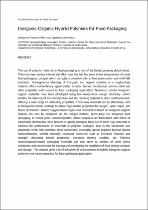JavaScript is disabled for your browser. Some features of this site may not work without it.
- ResearchSpace
- →
- Research Publications/Outputs
- →
- Book Chapters
- →
- View Item
| dc.contributor.author |
Kesavan Pillai, Sreejarani

|
|
| dc.contributor.author |
Ray, SS

|
|
| dc.date.accessioned | 2016-06-27T08:41:59Z | |
| dc.date.available | 2016-06-27T08:41:59Z | |
| dc.date.issued | 2015-09 | |
| dc.identifier.citation | Kesavan Pillai, S. and Ray, S.S. 2015. Inorganic-organic hybrid polymers for food packaging. In: Functional Polymer in Food Science, 9, 281–322 | en_US |
| dc.identifier.isbn | 978-1-118-59489-6 | |
| dc.identifier.uri | http://eu.wiley.com/WileyCDA/WileyTitle/productCd-1118594894.html | |
| dc.identifier.uri | http://hdl.handle.net/10204/8590 | |
| dc.description | Copyright: Wiley: New York, USA. Due to copyright restrictions, the attached PDF file only contains the abstract of the full text item. For access to the full text item, please consult the publisher's website. | en_US |
| dc.description.abstract | The use of polymer materials in food packaging is one of the fastest growing global trends. There has been serious interest and effort over the last few years in the advancement of novel food packaging concepts which can play a proactive role in food preservation and shelf-life extension. Homogeneous blending of inorganic and organic moieties in a single-phase material offers extraordinary opportunities to tailor barrier, mechanical, antimicrobial and other properties with respect to food packaging application. Numerous hybrid inorganic-organic materials have been developed using low temperature sol-gel chemistry, which enables the tailoring of the nanostructure and the resulting material is often multifunctional, offering a wide range of interesting properties. These new materials can be effectively used as transparent barrier coatings to obtain high-barrier properties for oxygen, water vapor, and flavor permeation. Active oxygen barrier layers and nanosensors based on inorganic-organic hybrids can also be produced via the sol-gel method, particularly for advanced food packaging. In recent years, nanocomposites, where polymers are formulated with fillers of nanometric dimensions, have become a rapidly emerging field due to their huge potential to improve the performance of materials in polymer packages. Due to the nanometer size dispersion of the filler particles, these composites, especially natural polymer-layered silicate nanocomposites, exhibit markedly improved properties such as increased modulus and strength, decreased barrier properties, increased thermal stability, etc. Polymer nanocomposites-based packaging materials can also serve as carriers of some active substances and nanosensors for tracing and monitoring the condition of food during transport and storage. This chapter gives a brief overview of developments in hybrid inorganic-organic polymers and nanocomposites for food packaging application. | en_US |
| dc.language.iso | en | en_US |
| dc.publisher | Wiley | en_US |
| dc.relation.ispartofseries | Workflow;16417 | |
| dc.subject | Inorganic-organic hybrid polymers | en_US |
| dc.subject | Sol-gel synthesis | en_US |
| dc.subject | Polymer nanocomposites | en_US |
| dc.subject | Properties | en_US |
| dc.subject | Food packaging | en_US |
| dc.title | Inorganic-organic hybrid polymers for food packaging | en_US |
| dc.type | Book Chapter | en_US |
| dc.identifier.apacitation | Kesavan Pillai, S., & Ray, S. (2015). Inorganic-Organic hybrid polymers for food packaging., <i>Workflow;16417</i> Wiley. http://hdl.handle.net/10204/8590 | en_ZA |
| dc.identifier.chicagocitation | Kesavan Pillai, Sreejarani, and SS Ray. "Inorganic-organic hybrid polymers for food packaging" In <i>WORKFLOW;16417</i>, n.p.: Wiley. 2015. http://hdl.handle.net/10204/8590. | en_ZA |
| dc.identifier.vancouvercitation | Kesavan Pillai S, Ray S. Inorganic-organic hybrid polymers for food packaging.. Workflow;16417. [place unknown]: Wiley; 2015. [cited yyyy month dd]. http://hdl.handle.net/10204/8590. | en_ZA |
| dc.identifier.ris | TY - Book Chapter AU - Kesavan Pillai, Sreejarani AU - Ray, SS AB - The use of polymer materials in food packaging is one of the fastest growing global trends. There has been serious interest and effort over the last few years in the advancement of novel food packaging concepts which can play a proactive role in food preservation and shelf-life extension. Homogeneous blending of inorganic and organic moieties in a single-phase material offers extraordinary opportunities to tailor barrier, mechanical, antimicrobial and other properties with respect to food packaging application. Numerous hybrid inorganic-organic materials have been developed using low temperature sol-gel chemistry, which enables the tailoring of the nanostructure and the resulting material is often multifunctional, offering a wide range of interesting properties. These new materials can be effectively used as transparent barrier coatings to obtain high-barrier properties for oxygen, water vapor, and flavor permeation. Active oxygen barrier layers and nanosensors based on inorganic-organic hybrids can also be produced via the sol-gel method, particularly for advanced food packaging. In recent years, nanocomposites, where polymers are formulated with fillers of nanometric dimensions, have become a rapidly emerging field due to their huge potential to improve the performance of materials in polymer packages. Due to the nanometer size dispersion of the filler particles, these composites, especially natural polymer-layered silicate nanocomposites, exhibit markedly improved properties such as increased modulus and strength, decreased barrier properties, increased thermal stability, etc. Polymer nanocomposites-based packaging materials can also serve as carriers of some active substances and nanosensors for tracing and monitoring the condition of food during transport and storage. This chapter gives a brief overview of developments in hybrid inorganic-organic polymers and nanocomposites for food packaging application. DA - 2015-09 DB - ResearchSpace DP - CSIR KW - Inorganic-organic hybrid polymers KW - Sol-gel synthesis KW - Polymer nanocomposites KW - Properties KW - Food packaging LK - https://researchspace.csir.co.za PY - 2015 SM - 978-1-118-59489-6 T1 - Inorganic-organic hybrid polymers for food packaging TI - Inorganic-organic hybrid polymers for food packaging UR - http://hdl.handle.net/10204/8590 ER - | en_ZA |






